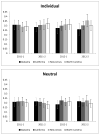Large-scale automated analysis of news media: a novel computational method for obesity policy research
- PMID: 25522013
- PMCID: PMC4449277
- DOI: 10.1002/oby.20955
Large-scale automated analysis of news media: a novel computational method for obesity policy research
Abstract
Objective: Analyzing news media allows obesity policy researchers to understand popular conceptions about obesity, which is important for targeting health education and policies. A persistent dilemma is that investigators have to read and manually classify thousands of individual news articles to identify how obesity and obesity-related policy proposals may be described to the public in the media. A machine learning method called "automated content analysis" that permits researchers to train computers to "read" and classify massive volumes of documents was demonstrated.
Methods: 14,302 newspaper articles that mentioned the word "obesity" during 2011-2012 were identified. Four states that vary in obesity prevalence and policy (Alabama, California, New Jersey, and North Carolina) were examined. The reliability of an automated program to categorize the media's framing of obesity as an individual-level problem (e.g., diet) and/or an environmental-level problem (e.g., obesogenic environment) was tested.
Results: The automated program performed similarly to human coders. The proportion of articles with individual-level framing (27.7-31.0%) was higher than the proportion with neutral (18.0-22.1%) or environmental-level framing (16.0-16.4%) across all states and over the entire study period (P<0.05).
Conclusions: A novel approach to the study of how obesity concepts are communicated and propagated in news media was demonstrated.
© 2014 The Obesity Society.
Conflict of interest statement
The authors have no conflicts of interest to disclose.
Figures





References
-
- McCombs ME, Shaw DL. The agenda-setting function of mass media. Public Opin Q. 1972;36:176–187.
-
- Dorfman L, Wallack L, Woodruff K. More than a message: Framing public health advocacy to change corporate practices. Health Educ Behav. 2005;32:320–336. - PubMed
-
- Gollust SE, Eboh I, Barry CL. Picturing obesity: Analyzing the social epidemiology of obesity conveyed through US news media images. Soc Sci Med. 2012;74:1544–1551. - PubMed
MeSH terms
Grants and funding
LinkOut - more resources
Full Text Sources
Other Literature Sources
Medical

